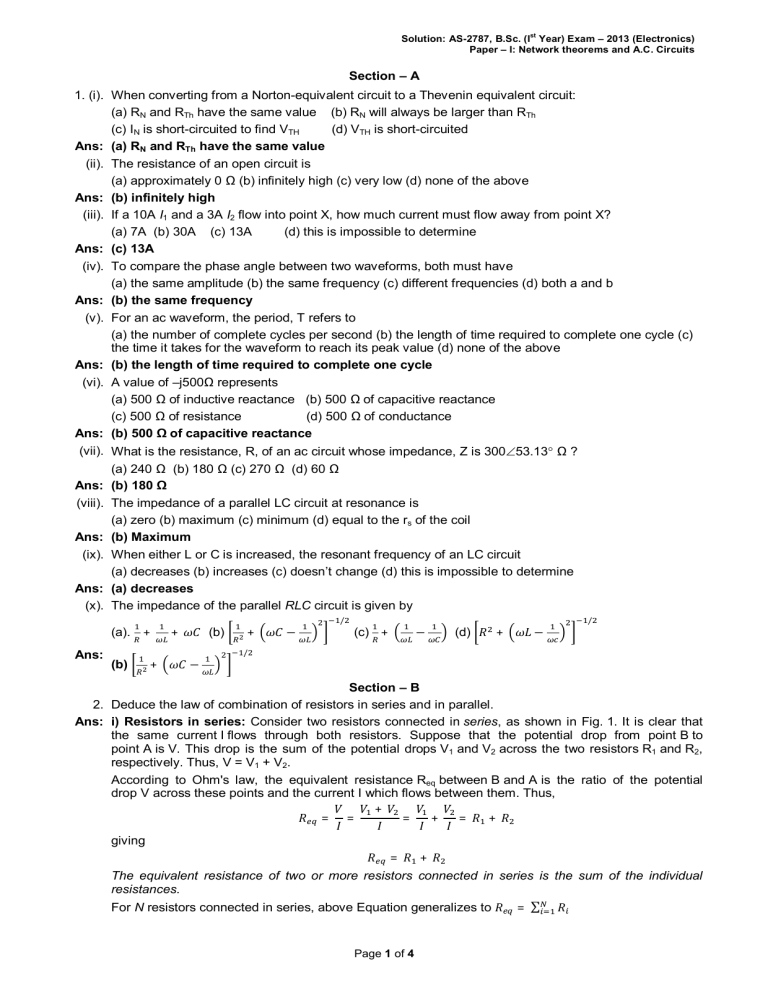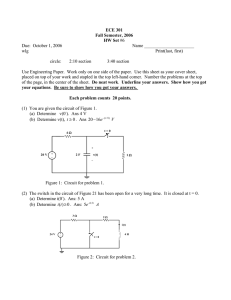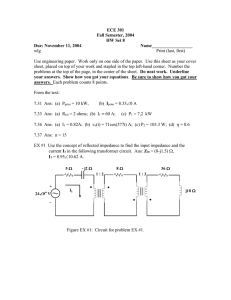Available

Solution: AS-2787, B.Sc. (I st
Year) Exam – 2013 (Electronics)
Paper – I: Network theorems and A.C. Circuits
Section – A
1. (i). When converting from a Norton-equivalent circuit to a Thevenin equivalent circuit:
(a) R
N
and R
Th
have the same value (b) R
N
will always be larger than R
Th
(c) I
N
is short-circuited to find V
TH
(d) V
TH
is short-circuited
Ans: (a) R
N
and R
Th
have the same value
(ii). The resistance of an open circuit is
(a) approximately 0 Ω (b) infinitely high (c) very low (d) none of the above
Ans: (b) infinitely high
(iii). If a 10A I
1
and a 3A I
2
flow into point X, how much current must flow away from point X?
(a) 7A (b) 30A (c) 13A (d) this is impossible to determine
Ans: (c) 13A
(iv). To compare the phase angle between two waveforms, both must have
(a) the same amplitude (b) the same frequency (c) different frequencies (d) both a and b
Ans: (b) the same frequency
(v). For an ac waveform, the period, T refers to
(a) the number of complete cycles per second (b) the length of time required to complete one cycle (c) the time it takes for the waveform to reach its peak value (d) none of the above
Ans: (b) the length of time required to complete one cycle
(vi). A value of –j500 Ω represents
(a) 500 Ω of inductive reactance (b) 500 Ω of capacitive reactance
(c) 500 Ω of resistance (d) 500 Ω of conductance
Ans: (b) 500 Ω of capacitive reactance
(vii). What is the resistance, R, of an ac circuit whose impedance, Z is 300 53.13
Ω ?
(a) 240 Ω (b) 180 Ω (c) 270 Ω (d) 60 Ω
Ans: (b) 180 Ω
(viii). The impedance of a parallel LC circuit at resonance is
(a) zero (b) maximum (c) minimum (d) equal to the r s
of the coil
Ans: (b) Maximum
(ix). When either L or C is increased, the resonant frequency of an LC circuit
(a) decreases (b) increases (c) doesn’t change (d) this is impossible to determine
Ans: (a) decreases
(x). The impedance of the parallel RLC circuit is given by
/
(a). + + (b) + − (c) + − (d) + −
/
Ans:
(b) + −
/
Section – B
2. Deduce the law of combination of resistors in series and in parallel.
Ans: i) Resistors in series: Consider two resistors connected in series , as shown in Fig. 1. It is clear that the same current I flows through both resistors. Suppose that the potential drop from point B to point A is V. This drop is the sum of the potential drops V
1
and V
2
across the two resistors R
1
and R
2
, respectively. Thus, V = V
1
+ V
2
.
According to Ohm's law, the equivalent resistance R eq
between B and A is the ratio of the potential drop V across these points and the current I which flows between them. Thus,
+
= = = + = + giving
= +
The equivalent resistance of two or more resistors connected in series is the sum of the individual resistances.
For N resistors connected in series, above Equation generalizes to = ∑
Page 1 of 4
Solution: AS-2787, B.Sc. (I st
Year) Exam – 2013 (Electronics)
Paper – I: Network theorems and A.C. Circuits
Fig. 1: Two resistors connected in series Fig. 2: Two resistors connected in parallel ii) Resistors in parallel: Consider two resistors connected in parallel , as shown in Fig. 2. It is clear, from the figure, that the potential drop V across the two resistors is the same. In general, however, the currents I
1
and I
2
which flow through resistors R
1
and R
2
, respectively, are different. According to Ohm's law, the equivalent resistance R eq
between B and A is the ratio of the potential drop V across these points and the current I which flows between them. This current must equal the sum of the currents I
1
and I
2
flowing through the two resistors, otherwise charge would build up at one or both of the junctions in the circuit.
Thus, I = I
1
+ I
2
It follows that = = = + giving
1
=
1
+
1
Clearly, t he reciprocal of the equivalent resistance of two resistances connected in parallel is the sum of the reciprocals of the individual resistances.
For N resistors connected in parallel, above equation generalizes to = ∑
3. State and explain Kirchhoff’s law with suitable examples.
Ans: Kirchhoff ’s Current Law (KCL): The algebraic sum of the currents entering and leaving any point in a circuit must equal zero. Or stated another way, the algebraic sum of the currents into any point of the circuit must equal the algebraic sum of the currents out of that point. An algebraic sum means combining positive and negative values. i.e.
= 0
Fig.1 Fig. 2
Example, in Fig.1, we can write the currents as
I
A
+ I
B
- I
C
= 0 or
5 A + 3 A - 8 A = 0
Currents I
A
and I
B
are positive terms because these currents flow into P, but I
C
, directed out, is negative.
Kirchhoff ’s Voltage Law (KVL): The algebraic sum of the voltages around any closed path is zero. If you start from any point at one potential and come back to the same point and the same potential, the difference of potential must be zero. i.e.
= 0
Example: Figure 2 has three loops. The outside loop, starting from point A at the top, through CEFDB, and back to A, includes the voltage drops V
1
, V
4
, V
5
and V
2
and the source V
T
.
The inside loop ACDBA includes V
1
, V
3
, V
2
, and V
T
. The other inside loop, CEFDC with V
4
, V
5
, and V
3
, does not include the voltage source. Consider the voltage equation for the inside loop with V
T
. In the clockwise direction starting from point A, the algebraic sum of the voltages is V
1
+ V
3
+ V
2
- V
T
= 0
Page 2 of 4
Solution: AS-2787, B.Sc. (I st
Year) Exam – 2013 (Electronics)
Paper – I: Network theorems and A.C. Circuits
4. For a any network, loop equations are: 8 − 3 − 5 = 5 , − 3 + 7 = − 10 , and − 5 + 11 = − 10 .
Determine the value of i
1
, i
2
and i
3
.
Ans: For a network, Loop equations given by
8 − 3 − 5 = 5
− 3 + 7 = − 10
− 5 + 11 = − 10
There are three equations and three unknowns, Using third-order determinants, we have
=
−
5
10
−
7
3 −
− 3 7 0
0
8 − 3 − 5
− 5 0 11
5
− 10 0 11
= −
50
57
,
8 − 3 − 5
− 3 7 0
− 5 0 11
8 5 − 5
=
− 3 − 10 0
− 5 − 10 11
8 − 3 − 5
− 3 7 0
− 5 0 11
=
= −
−
−
5
10
10
205
114
= ,
= − 0.88, = − 1.8, = − 1.30
=
−
5
10
−
7
3
−
5
10
− 10 0 − 10
8 − 3 − 5
− 3 7 0
− 5 0 11
5. Describe in details the conversion of T to delta sections.
Ans:
= −
445
342
Fig. 1: T (tee) and delta (pi) network
Consider fig. 1, to find , and for both network (T and delta)
(
Impedance at 1,1, when terminal 2,2 open, = + =
)
-------(1)
Impedance at 2,2, when terminal 1,1 open, = + =
( )
-------(2)
Impedance at 1,1, when terminal 2,2 short circuit, = + = -------(3)
Subtracting eq.(3) form eq.(1) − =
( )( )
-------(4)
Multiply eq. (2) and eq. (4) =
(
Using eq. (5) in eq. (1) and (2) =
Multiply eq. (2) and eq. (3) +
)
⟹ =
, =
+ =
-------(5)
-------(6)
-------(7)
Divide eq. (7) by eq. (5) and eq.(6), we get
= , = , = -------(8)
Equation (8) shows conversion between T to delta network.
6. The voltage across a resistor is V = 100 377 . Find the sinusoidal expression for the current if the
Ans: resistor is 10 . Sketch the curves for V and I.
= =
100
10
(v and i are in phase), resulting in
= 10
= 10 377
The curves are sketched in Fig.
Page 3 of 4
Solution: AS-2787, B.Sc. (I st
Year) Exam – 2013 (Electronics)
Paper – I: Network theorems and A.C. Circuits
7. What is the difference between the series and parallel resonant circuits?
Ans: Difference between the series and parallel resonant circuits
Series Resonance
Resonance frequency, =
Parallel Resonance
√
Resonance frequency, = −
Current maximum at f r
Impedance (Z) minimum at f r
Total impedance Z = R
Current minimum at f r
Impedance Z maximum at f r
Total impedance =
Circuit capacitive below f r
, but inductive above f r
Circuit inductive below f r
, but capacitive above f r
Voltage drops at L and C are equal and opposite phase
Current in L and C equal and opposite phase
This is acceptor circuit This is rejecter circuit
8. For the series resonant circuit of given Fig., find I , V
R
, V
L
, and V
C at resonance.
Ans: Total impedance in series resonance circuit is
= + −
Current in circuit is
= 2 Ω
= =
10 ∠ 0°
= 5 ∠ 0°
2 Ω
Voltage drop at resistance
= = 10 ∠ 0°
Voltage drop at inductance
= ( ∠ 0°)( ∠ 90°) = 50 ∠ 90°
Voltage drop at capacitance
= ( ∠ 0°)( ∠ − 90°) = 50 ∠ − 90°
Page 4 of 4



